Over the last few decades, service blueprints have evolved as a useful method to address the many challenges in service design and innovation. It was first introduced by Lynn Shostack, a banking executive in 1982 in the Harvard Business Review.
In this guide, we’ll be taking a deep dive into the topic of service blueprints; at the end of it, you’ll know what is a service blueprint, how to create one as well as how to read one. You can start blueprinting your own service process right away with the templates provided.
- What is a Service Blueprint
- Key Elements of the Service Blueprint
- Benefits of a Service Blueprint
- Applications of a Service Blueprint
- How to Read the Service Blueprint
- How to Create a Service Blueprint Using Creately
- Service Blueprint Examples
- Ready to Create Your Own Service Blueprint?
What is a Service Blueprint
The service blueprint is a diagram/ map that visualizes a service offering accurately. It provides a clear picture of the service process to those who are involved in service production as well as service consumption.
Its purpose is to help understand the service delivery process from the customers’ perspective in order to assist the service design and improvement processes. It highlights the complexity and divergence of the service process and helps to upgrade the efficiency and effectiveness in customer service.
They are particularly used during the design stage of service development to break a service down to its logical components such as points of customer contacts, physical evidence, etc. and analyze the steps in the service process in detail.
They are usually represented with a diagram with swimlanes which represent the different categories of the service blueprint.
Service Blueprint vs. Customer Journey Map
Customer journey map and service blueprints are two complementary methods used in service/ product design.
Customer journey maps visualize the customer experience across different touchpoints along with what they are doing, thinking, and feeling. It focuses more on the surface customer experience and reveals less service process details.
On the other hand, service blueprints offer a detailed look at the service delivery process across the different touchpoints, including the onstage and backstage contact employee actions.
So the service blueprint offers more information on the internal processes and support systems that deliver the service to the customers more than the experience of the customer. The blueprint uses the customer journey as a starting point.
Key Elements of the Service Blueprint
The service blueprint distinguishes between onstage and backstage employee activities which are represented with its key components.
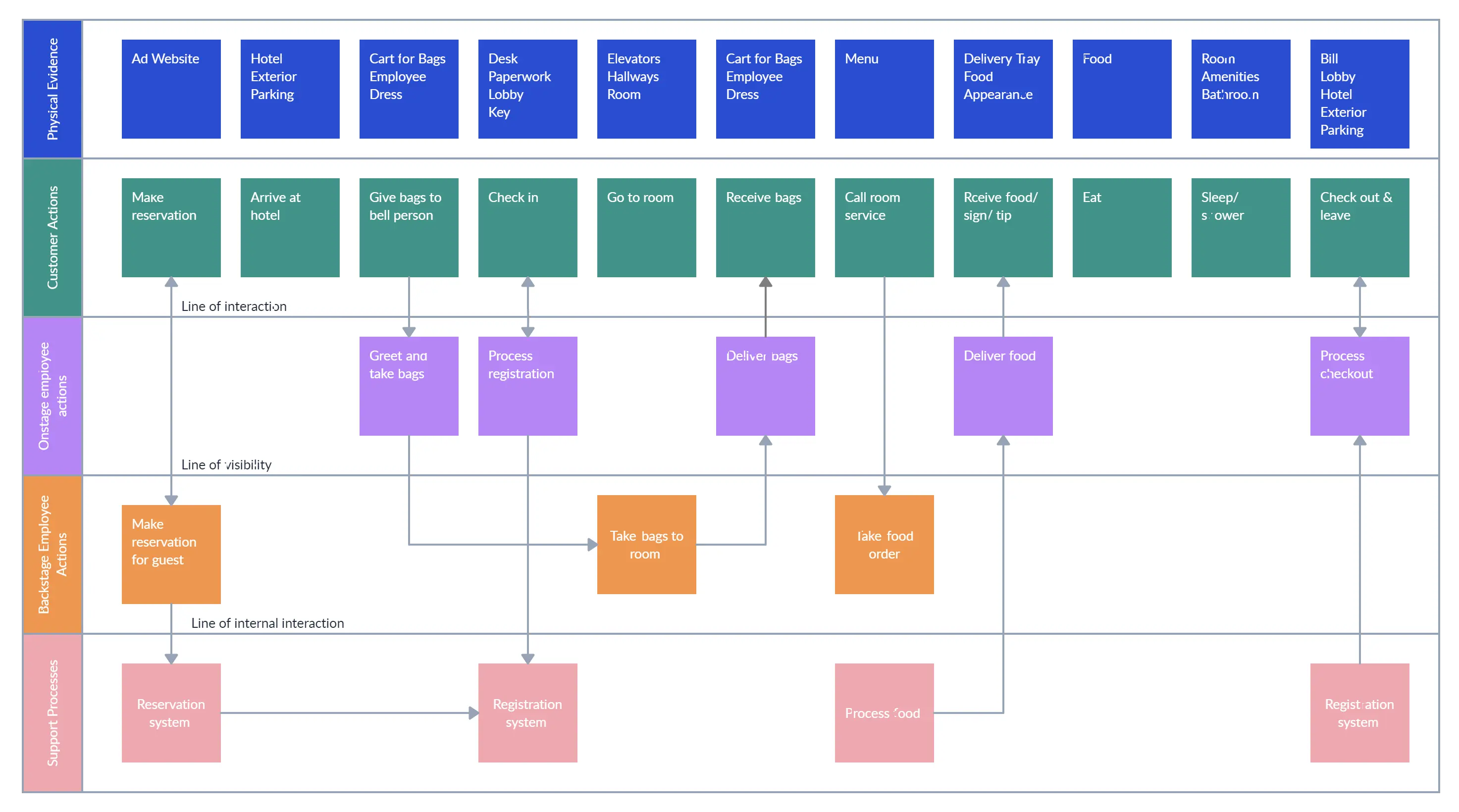
Customer actions: this component is central to the creation of the service blueprint and therefore is laid out first. It includes the steps, actions, choices, and interactions the customer performs while evaluating, purchasing or using the service delivery process. These actions are displayed chronologically across the top of the blueprint.
Onstage/ visible contact employee actions: this component appears on the diagram after customer actions, separated by the line of interaction. These actions include what frontline contact employees do when they encounter customers face-to-face.
Backstage/ invisible contact employee actions: this refers to the backstage or behind the scene actions taken by contact employees that are not visible to the customer. They include non-visible interactions with the customer such as telephone calls and other activities backstage contact employees carry out to support the onstage activities.
Support processes: this includes all the actions, interactions, internal services carried out by individuals or units (not contact employees) within the company to support contact employees deliver the service. They are not visible to the customers.
Physical evidence: this comes at the top of the diagram and represents the physical evidence of the service. They are typically listed above each point of contact. For example, the physical evidence of a face-to-face meeting can be listed as office decor.
Lines: Each component of the service blueprint is separated by a line. First comes the line of interaction which represents direct interaction between the customer and the organization; every time the line of interaction is crossed by a link from the customer to the contact employee, a moment of truth occurs. During these moments of truths, the customer judges the quality of the service and makes decisions about future purchases.
Then comes the line of visibility. All components that come above this line are visible to the customer while the ones that come below it are invisible.
The last is the internal line of interaction. This separates contact employee activities from other service support activities and people. Vertical lines cutting across the line of internal interaction represent internal service encounters.
Arrows: These represent the relationships/ dependencies. A single arrow indicates a one-way exchange, and a double arrow indicates the need for agreement from both parties or codependence.
Some secondary elements you can include in a service blueprint are,
Time: If time is an essential part of your service, you can use a timeline to represent the estimated time duration for each step of the process.
Emotions: Similar to the way a customer journey map reveals the emotions customers go through during each step of their journey, you can indicate the various emotional states your employees are in during each step of the service delivery process.
Metrics: You can also include success metrics in your service blueprint to track the progress toward your goals.
Benefits of a Service Blueprint
The service blueprint helps organizations to effectively understand their services – the resources and the underlying processes. There are several other benefits of service blueprints
- Streamlined service delivery: A service blueprint provides a clear overview of the different processes, activities, and touchpoints involved in delivering a service. It helps organizations identify redundancies, bottlenecks, and areas of inefficiency, allowing for process optimization and streamlining. A service blueprint also helps check the process’s logical flow and evaluate its effectiveness and productivity.
- Enhanced customer experience: Service blueprints allow organizations to identify pain points and areas for improvement in the customer journey. It helps to understand customer needs and wants and the impact of a failed delivery service. By mapping out the entire service process, organizations can identify moments of truth, optimize interactions, and design better customer experiences.
- Improved service design and innovation: By visualizing the service process, organizations can spot opportunities for innovation and new service offerings. Using a service blueprint, you can isolate service systems that are slow, repetitive, overly complex, waste resources and are toxic to the customer. Service blueprints enable service designers to identify areas where technology, automation, or new approaches can be implemented to enhance the service and provide additional value to customers.
- Measurement and performance evaluation: Service blueprints provide a framework for measuring service performance and evaluating key metrics at each step of the process. By tracking and analyzing data related to service delivery, organizations can identify areas for improvement, set benchmarks, and monitor progress over time. A service blueprint helps with measuring the cost of service delivery and identifying opportunities for improving the service delivery system.
- Cross-functional collaboration: Service blueprints involve multiple stakeholders and departments, facilitating team collaboration and communication. It helps break down silos and fosters a shared understanding of the service process, allowing for coordinated efforts in delivering an exceptional service experience. You can also use them to understand cross-functional relationships in your organization and align front-stage and back-stage actions.
- Training and employee empowerment: Service blueprints can be used as training tools for employees, providing a step-by-step guide to service delivery. They help employees understand their roles and responsibilities and how their actions impact the service experience. This empowers employees to make informed decisions and deliver consistent, high-quality service.
- Service recovery and problem-solving: When service failures or issues occur, service blueprints serve as a valuable tool for identifying the root causes and developing solutions. By pinpointing the specific steps and touchpoints where problems arise, organizations can implement effective service recovery strategies and prevent similar issues in the future.
Applications of a Service Blueprint
Service blueprints have various applications across industries and sectors. Here are some common applications of service blueprints,
- Service Design: Service blueprints are used to understand the customer journey, identify pain points, and design customer-centric experiences.
- Customer Experience Management: Service blueprints help manage and improve customer experiences by aligning processes, policies, and resources to meet customer expectations.
- Process Optimization: Service blueprints identify inefficiencies, bottlenecks, and redundant activities, improving efficiency, reducing costs, and enhancing service quality.
- Service Innovation: Service blueprints act as a foundation for identifying opportunities and implementing innovative solutions to enhance the service experience.
- Employee Training and Onboarding: Service blueprints are used as training tools to help employees understand their roles, responsibilities and how their actions contribute to the overall service experience.
- Service Recovery: Service blueprints assist in analyzing service failures, identifying root causes, and developing effective strategies for service recovery.
- Cross-functional Collaboration: Service blueprints promote collaboration and communication among departments by providing a shared understanding of the service process and interdependencies.
- Performance Measurement and Evaluation: Service blueprints provide a framework for measuring and evaluating service performance, allowing organizations to identify areas for improvement, set benchmarks, and monitor progress.
How to Read the Service Blueprint
A service blueprint can be read in multiple ways. In this section, we will show you how to read and understand them for different purposes.
To understand the customers’ view of the process or of their experience; read the service blueprint from left to right while tracking the elements in the customer action category. You can understand the view of the customer by focusing on how they initiate the service, the choices they make, how involved they are in creating the service, the physical evidence of the service from their point of view and whether the evidence is consistent with the strategy and positioning of the evidence.
To understand the role of the contact employees; read the diagram horizontally focusing on the activities that are directly above and below the line of visibility. Here you can look into how effective and efficient the process is, who interacts with the customer and how often they do so and whether there is one or several people to deal with a customer.
To understand how the various elements of the service process are integrated; Here you need to analyze the blueprint vertically. This analysis will help you identify which employees and which tasks are essential to effectively deliver the service to customers. Focus on what actions are performed backstage to assist the critical customer interaction points, what the supporting actions are, and how the handoffs between employees are taking place.
To redesign the service process; Here you can analyze the service blueprint as a whole. By doing so you can understand its complexity, how it can be changed and how changes in the customer’s point of view may affect the contact employee actions and internal processes. You can also use the blueprint to evaluate inefficiencies and failure points and identify opportunities for improvement and redesign.
How to Create a Service Blueprint Using Creately
The process of building a service blueprint itself has many benefits. It’ll help develop a shared vision of the service process among everyone involved, identify complexities of the service that were never apparent and understand the roles and responsibilities of the task owners.
The development of the service blueprint requires a cross-functional team consisting of members from marketing, operations, HR, and in some cases, even customers.
You can simplify the process of creating a service blueprint by using an online diagramming tool like Creately. It enables you and your team to work on the same canvas with infinite space in real-time.
And using comments and discussion threads you can monitor feedback from stakeholders. There are many pre-made templates as well, and you can use them right away to start your project.
Step 1: Identify the service process to be blueprinted
Whether it is a main process or sub-process, it’s important to have identified what it is beforehand. Once you have determined the underlying purpose for creating the service blueprint, you can identify which process to start with. Focus on blueprinting one process at a time.
Gather everyone on your team to the Creately platform to brainstorm and identify the service process. Use Creately’s integrations with Microsoft Teams to conduct online meetings seamlessly. Track the participation of the team with multi-cursors for any number of participants.
Step 2: Identify the customer segment
Different customer segments may have different needs and requirements, therefore your service may change from segment to segment. If your service process varies across different customer segments you cater to, then it’s important to blueprint these processes separately.
Dedicate the second step to identifying the particular customer segment the identified service process caters to. Once that’s specified, you need to get an idea about the interactions of the customers during each step of the process. For this you can use Creately’s pre-made templates to get a quick start.
A good way to understand the customer interactions or the choices and the actions they perform across the various service touchpoints is the customer journey map. Since the service blueprint is primarily about the employee actions, your customer journey map for this step doesn’t have to be a comprehensive one – one that highlights the touchpoints and the parallel actions would suffice.
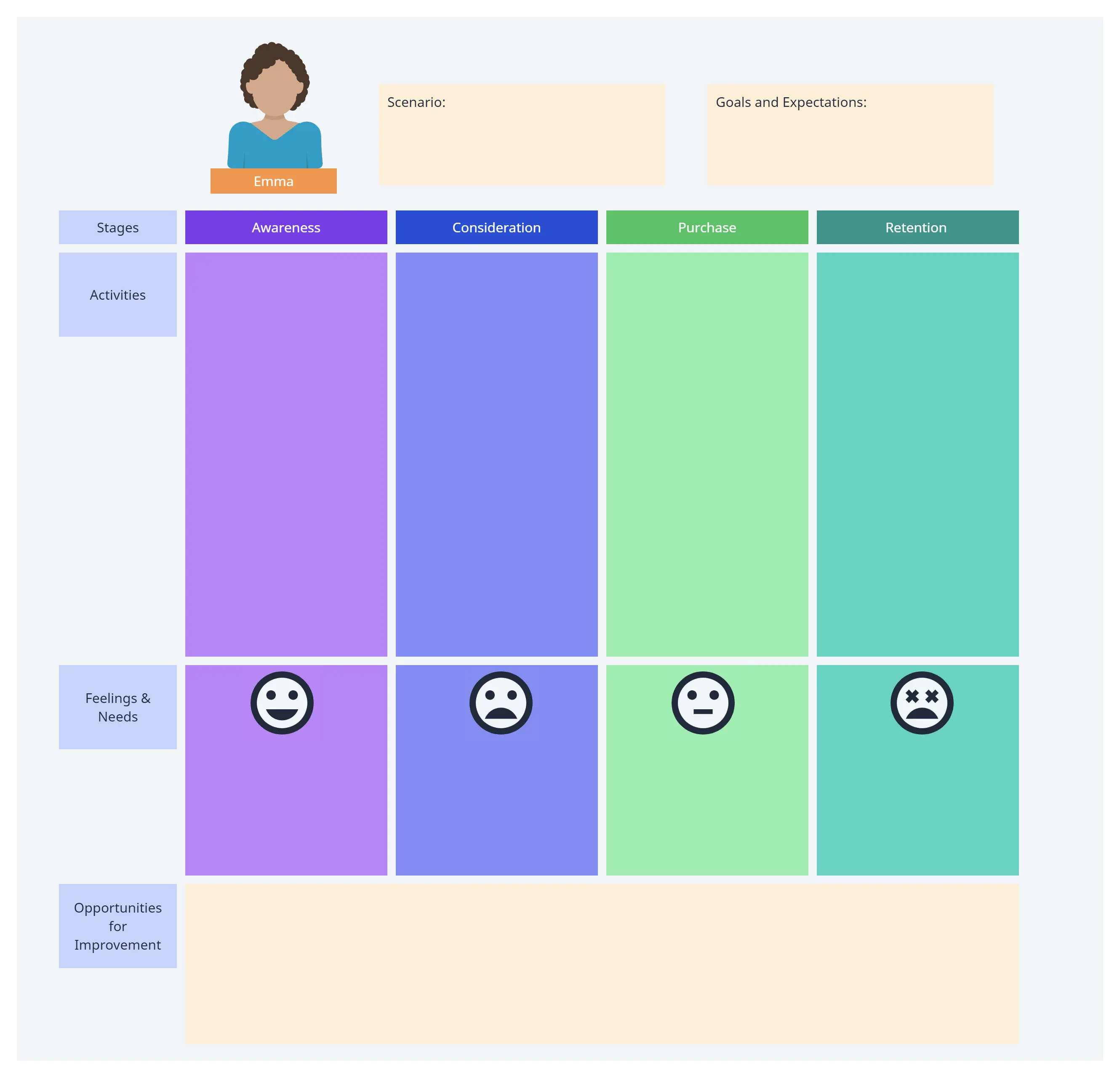
However, it is important to thoroughly understand who the customer is, which may require considerable research.
If you already have customer profiles for different segments, you can use them at this point; if not consider creating one for they may come in handy when you are blueprinting service processes anytime.

This will help you get an idea about the process from the point of view of the customer. And it will also help you identify and avoid process steps that have no customer impact.
Step 3: Map onstage/ backstage contact employee actions
This step starts with mapping the service process from the point of view of the contact employee both frontstage and backstage. You can question operations employees to gather the relevant information on the activities they perform in full view of the customer and which are carried out behind the scenes.
If technology is involved in delivering the service, you can map the actions on the technology interface.
Ask your team members to provide their input. Use sticky notes, shapes, notes and data panel to note down all information and to start sketching out the service blueprint.
Step 4: Link contact activities to needed support functions
Map the support processes the employees rely on to carry out the actions you identified above the line of interaction. These activities may involve employees from different departments of the organization, even those who are don’t directly interact with customers.
Once the support functions are identified, link the contact activities to them. This step will help you understand the direct and indirect impact of internal actions on the customers.
Use the dynamic connectors to link activities. You can also color code and customize the connectors.
Step 5: Add physical evidence of service at each customer action step
Finally, add the physical evidence to the map. This highlights what the customer sees or receives as tangible evidence of the service during each step of their experience.
Step 6: Fine-tune and share
In the final step of creating a service blueprint, you can add additional elements such as time indicators, metrics, or employee emotions to refine your diagram even further.
Then share it across the organization to communicate your take on how the internal organizational processes work.
With Creately, you can simply do this by exporting your diagrams in PDF, SVG, PNG, JPEG formats, which you can then publish or embed in your internal wikis, websites or take printouts.
You can also share it through Slack where anyone in the channel can easily preview the blueprint without having to log in to Creately first.
Or you can use the Creately Google Drive integration to create, share, store and manage permissions to your service blueprints right within the application.
If you rely on Confluence for project management, you may also find the Creately Plugin for Confluence useful as it works natively inside your on-premise Confluence server and lets you add visuals and diagrams as attachments to your pages and posts.
Service Blueprint Examples
Restaurant Service Blueprint

Hospital Service Blueprint
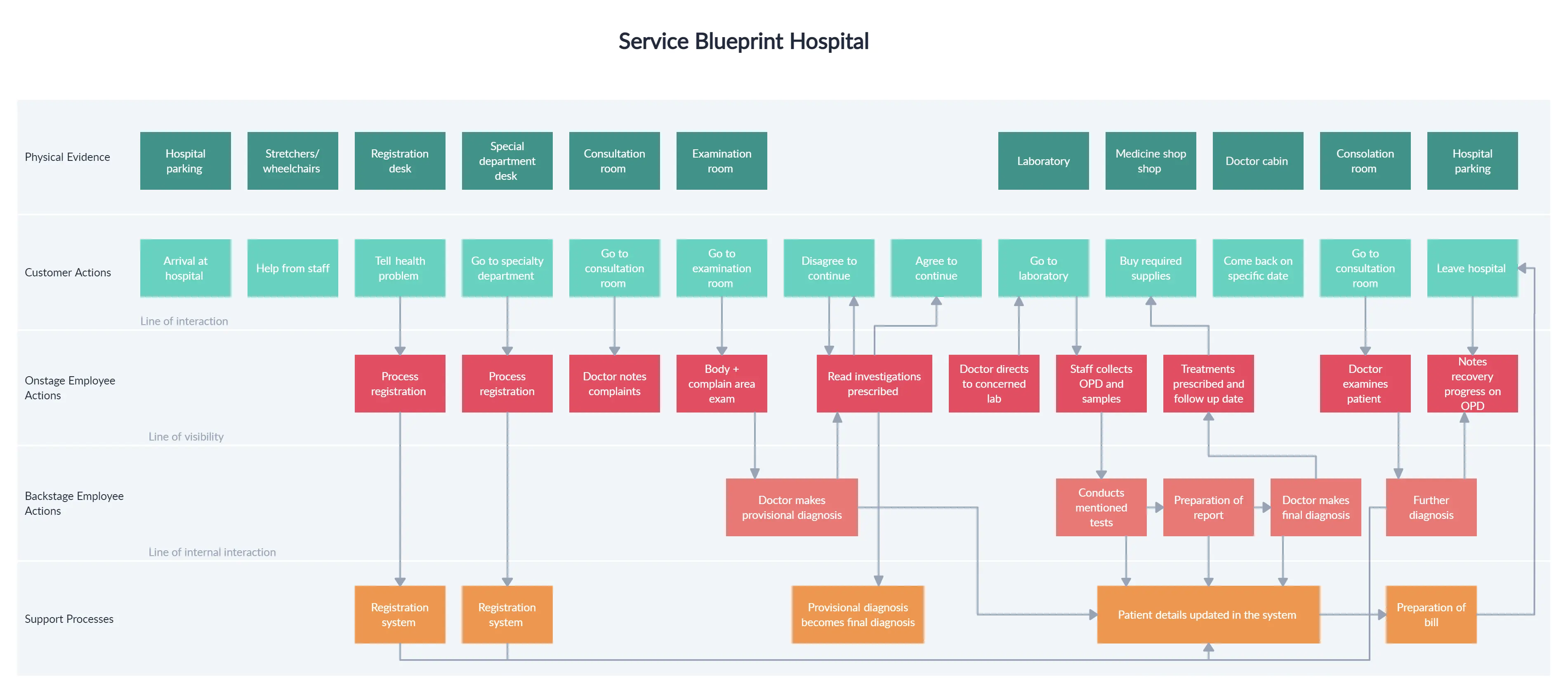
Hotel Service Blueprint

Movie Theater Service Blueprint
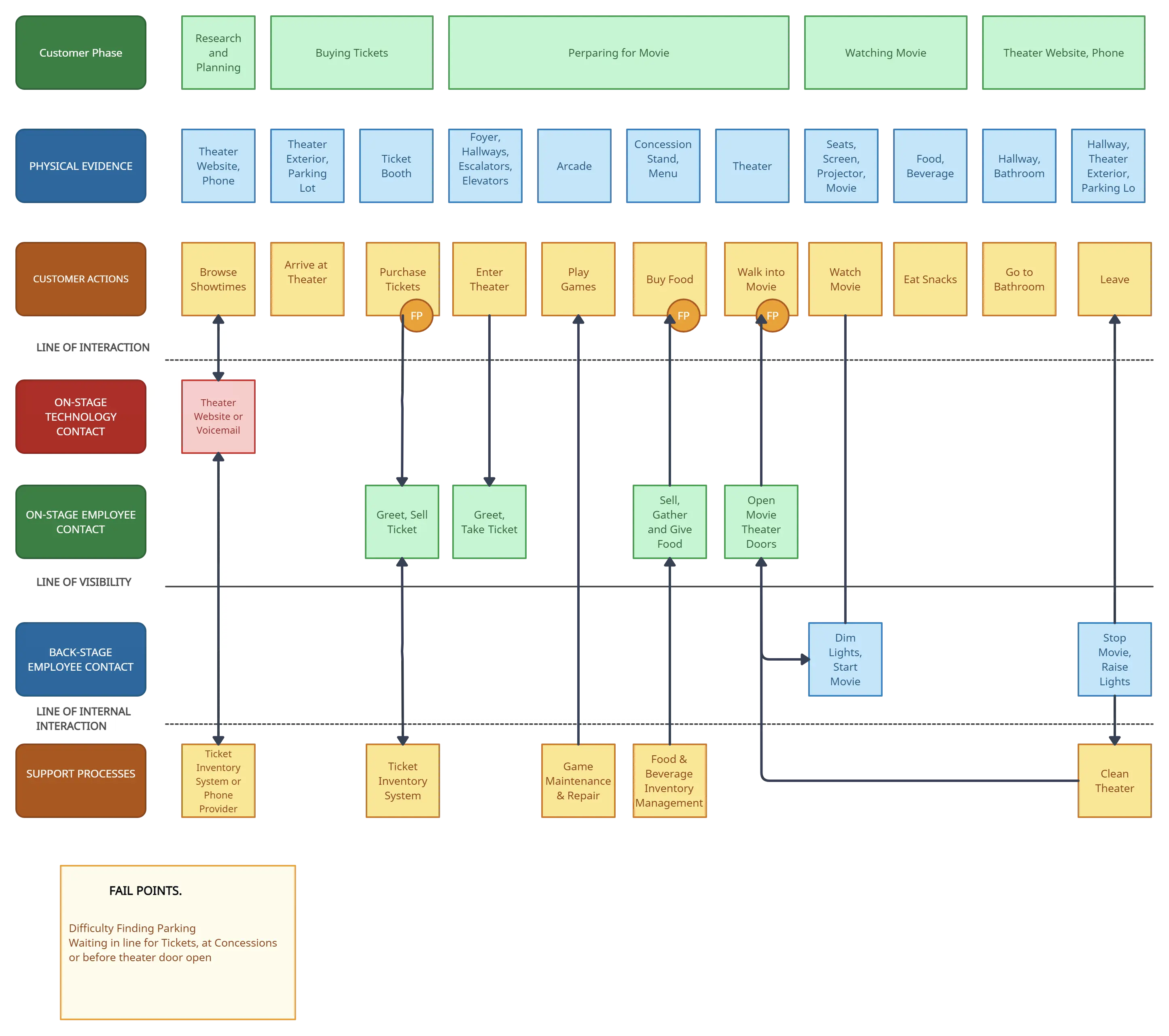
Commonwealth Bank Service Blueprint
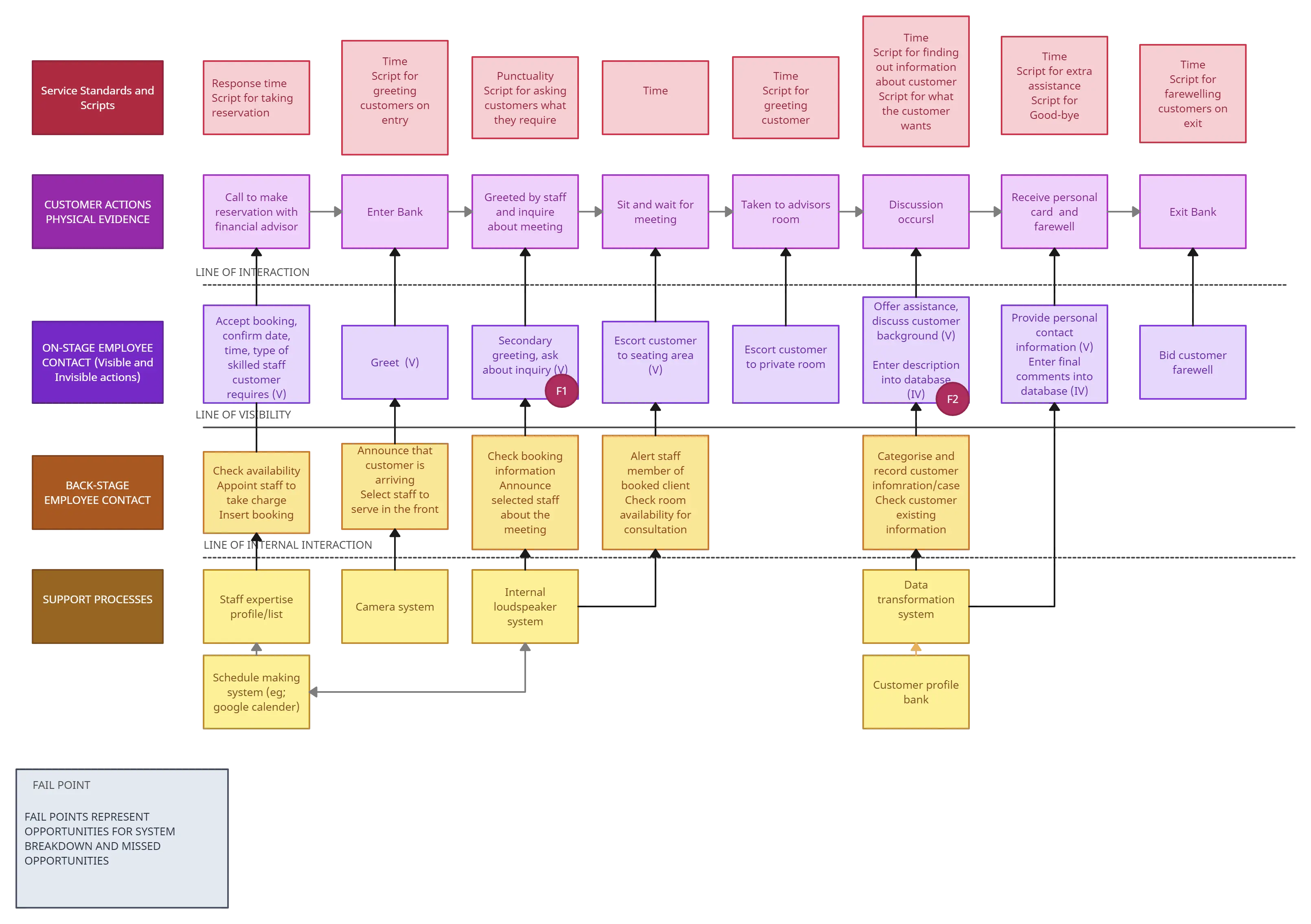
Finance Industy Service Blueprint

New Service Blueprint for a Coffee Shop
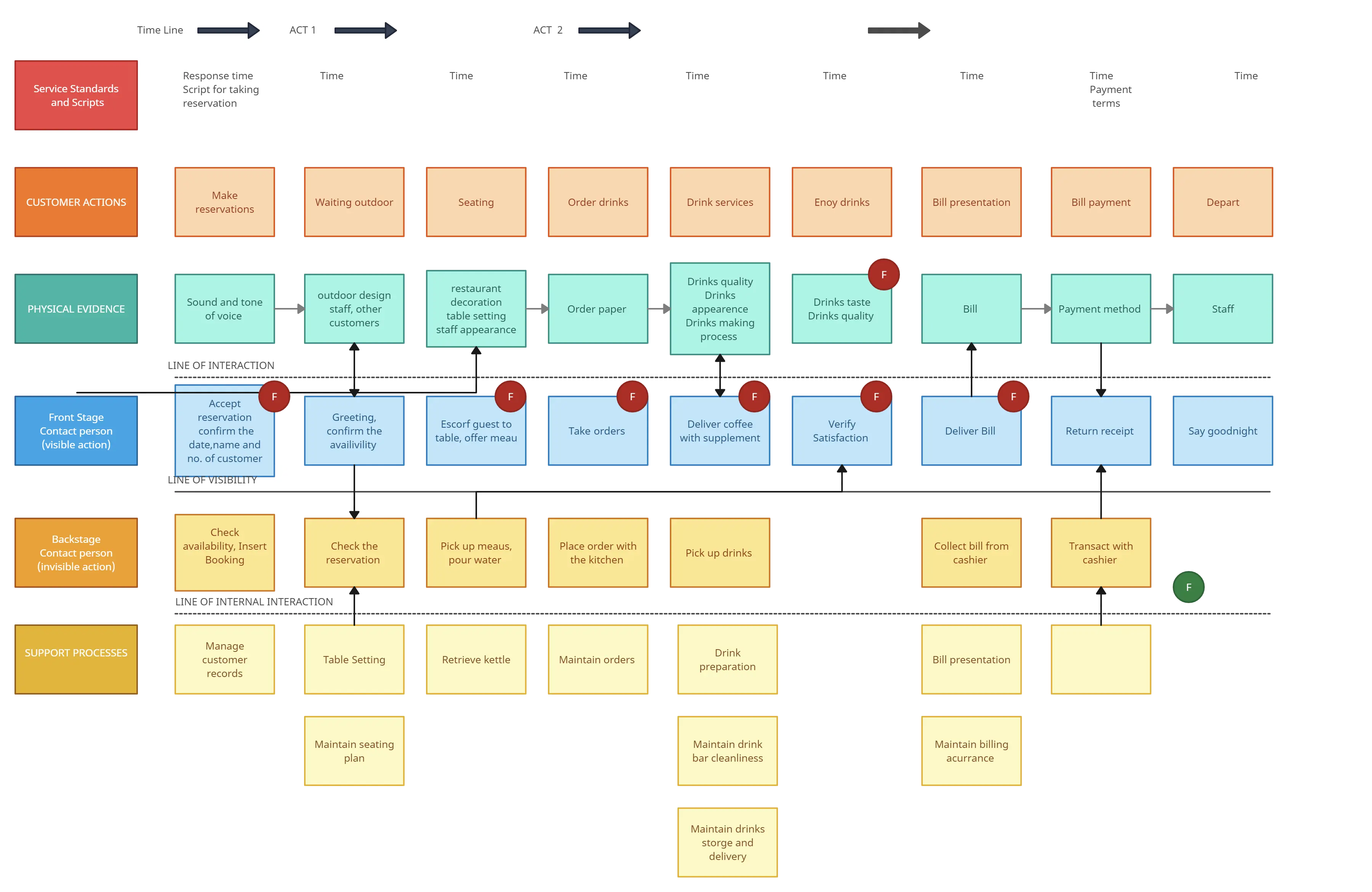
Example Uber Service Blueprint
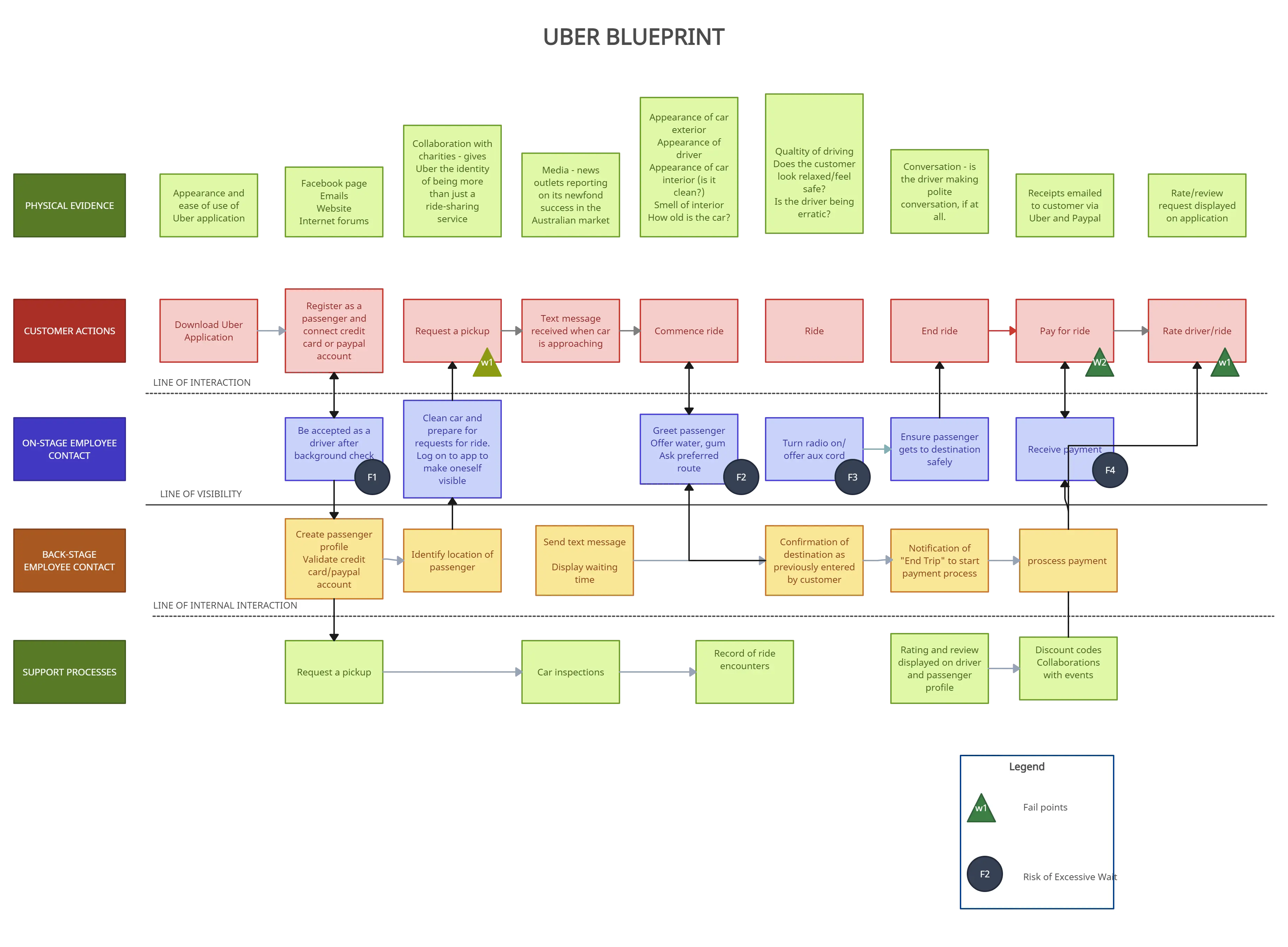
Ready to Create Your Own Service Blueprint?
As the name suggests, a service blueprint offers a blueprint of your service process. It simplifies the task of mapping out everything from each step of the process to the different roles in it, making it easier to design a new service delivery system or improve an existing one. This guide explains how to do this in detail.
Got anything to add? Let us know in the comments section below.
FAQs About Service Blueprints
How can service blueprints help identify and improve customer touchpoints?
How can service blueprints contribute to service innovation and new service development?
Are there any limitations or challenges in using service blueprints?
While service blueprints are valuable tools, there are a few limitations and challenges to consider.
- It can be challenging to capture the complexity and variability of the service process accurately.
- Service blueprints may not fully capture emotional or intangible aspects of the customer experience.
- Creating and maintaining service blueprints require collaboration among various stakeholders, which can be challenging in organizations with siloed departments or limited resources.
How can organizations effectively implement and maintain service blueprints?
Organizations should follow a few key steps to effectively implement and maintain service blueprints.
- Firstly, identify the scope and objectives of the blueprint.
- Involve relevant stakeholders from different departments to ensure a comprehensive understanding of the service process.
- Collect and analyze data on customer interactions and experiences to inform the blueprint.
- Regularly review and update the blueprint to align with service offerings or customer expectations changes.
- Finally, communicate the blueprint to all relevant employees to ensure a shared understanding.
Are there any best practices or tips for creating impactful service blueprints?
Here are some best practices for creating impactful service blueprints:
- Involve cross-functional teams to gain diverse perspectives and insights.
- Engage with customers through research methods like interviews, observations, and surveys to understand their needs and expectations.
- Use clear visual representations, such as diagrams or flowcharts, to make the blueprint easy to understand.
- Include relevant details in each step, such as customer actions, employee actions, and support processes.
- Pay attention to touchpoints where customer interactions occur, and analyze the emotions and expectations associated with those touchpoints.
- Iterate and refine the blueprint based on feedback and data from real-world service experiences.
- Regularly review and update the blueprint to ensure its accuracy and relevance.





